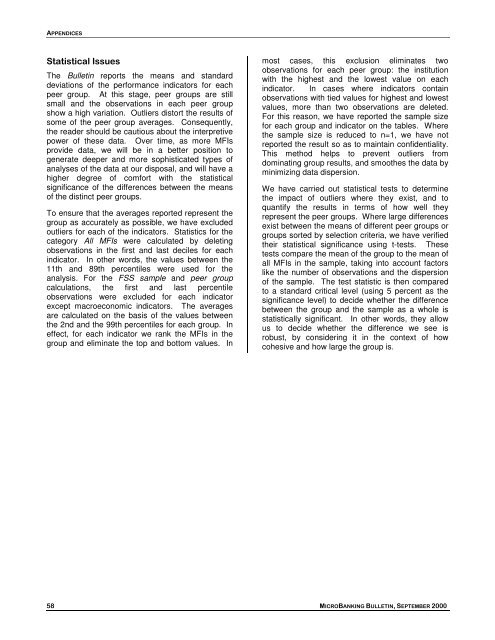APPENDICESStatistical IssuesThe Bulletin reports the means and standarddeviations of the performance indicators for eachpeer group. At this stage, peer groups are stillsmall and the observations in each peer groupshow a high variation. Outliers distort the results ofsome of the peer group averages. Consequently,the reader should be cautious about the interpretivepower of these data. Over time, as more MFIsprovide data, we will be in a better position togenerate deeper and more sophisticated types ofanalyses of the data at our disposal, and will have ahigher degree of comfort with the statisticalsignificance of the differences between the meansof the distinct peer groups.To ensure that the averages reported represent thegroup as accurately as possible, we have excludedoutliers for each of the indicators. Statistics for thecategory All MFIs were calculated by deletingobservations in the first and last deciles for eachindicator. In other words, the values between the11th and 89th percentiles were used for theanalysis. For the FSS sample and peer groupcalculations, the first and last percentileobservations were excluded for each indicatorexcept macroeconomic indicators. The averagesare calculated on the basis of the values betweenthe 2nd and the 99th percentiles for each group. Ineffect, for each indicator we rank the MFIs in thegroup and eliminate the top and bottom values. Inmost cases, this exclusion eliminates twoobservations for each peer group: the institutionwith the highest and the lowest value on eachindicator. In cases where indicators containobservations with tied values for highest and lowestvalues, more than two observations are deleted.For this reason, we have reported the sample sizefor each group and indicator on the tables. Wherethe sample size is reduced to n=1, we have notreported the result so as to maintain confidentiality.This method helps to prevent outliers fromdominating group results, and smoothes the data byminimizing data dispersion.We have carried out statistical tests to determinethe impact of outliers where they exist, and toquantify the results in terms of how well theyrepresent the peer groups. Where large differencesexist between the means of different peer groups orgroups sorted by selection criteria, we have verifiedtheir statistical significance using t-tests. Thesetests compare the mean of the group to the mean ofall MFIs in the sample, taking into account factorslike the number of observations and the dispersionof the sample. The test statistic is then comparedto a standard critical level (using 5 percent as thesignificance level) to decide whether the differencebetween the group and the sample as a whole isstatistically significant. In other words, they allowus to decide whether the difference we see isrobust, by considering it in the context of howcohesive and how large the group is.58 <strong>MICROBANKING</strong> <strong>BULLETIN</strong>, SEPTEMBER 2000
APPENDICESAppendix II: Description of Participating MFIsACRONYM NAME, LOCATION DATE15 de Abril Cooperativa 15 de Abril,Ecuador23 de Julio Cooperativa 23 de Julio,EcuadorABAACEPACLEDAACODEPACREDICOMACTUARADOPEMADRIAGAPEAgrocapAKRSPAl MajmouaAl AmanaAlexandria BusinessAssociation,EgyptAgence de Crédit pourl’Enterprise Privée,SenegalAssociation of CambodianLocal EconomicDevelopment Agencies,CambodiaAsociación de Consultorespara el Desarrollo de laPequeña, Mediana yMicroempresa,NicaraguaACREDICOM,GuatemalaCorporación Acción por elTolima - ACTUARFamiempresas,ColombiaAsociación Dominicanapara el Desarrollo de laMujer,Dominican RepublicAsociación para elDesarrollo Rural Integrado,Costa RicaAsociación General paraAsesorar PequeñasEmpresas,ColombiaFundación Agrocapital,BoliviaAga Khan Rural SupportProgramme,PakistanLebanese Association forDevelopment -- AlMajmoua,LebanonAssociation Al Amana,MoroccoDATAQUALITYRATINGDESCRIPTION OF MICROFINANCE PROGRAM06/99 AAA 15 de Abril is a credit union in Ecuador that has participated inWOCCU’s technical assistance program since in 1995. 15 de Abriloffers both credit and voluntary savings services to members.06/99 AAA 23 de Julio participates in WOCCU’s technical assistance program inEcuador. It is a credit union offering credit and savings services tomembers.12/99 AAA ABA provides credit to small and microenterprises using anindividual lending methodology. It is an NGO founded in 1988 andbased primarily in urban areas. The credit program began in 1990.12/99 B ACEP began as an NGO in a provincial town in 1987 and hasexpanded to operate in other urban areas in Senegal. It hasconverted to a credit union.12/99 AAA ACLEDA was started in 1993 as an NGO. It provides small andmicro loans to enterprises and trains entrepreneurs in smallbusiness management. Both group and individual loans are made.12/98 B Founded in 1989, ACODEP serves small and micronterprisesprimarily in Managua and other urban areas of Nicaragua. It iscurrently negotiating a voluntary supervision agreement with theSuperintendent of Banks in Nicaragua.09/99 AAA ACREDICOM is a member of the FENACOAC credit union system inGuatemala, and participated in WOCCU’s technical assistanceprogram. It primarily lends for agriculture and to a lesser extentmicroenterprise activities, and mobilizes savings from members.12/99 B ACTUAR Tolima was founded in 1986. It is an NGO offering loansto microenterprises in Tolima and surrounding areas, and is affiliatedwith ACCION International and Cooperativa Emprender in Colombia.12/99 A ADOPEM, an affiliate of Women’s World Banking, is an NGOdedicated to credit for women microentrepreneurs. It has been inoperation since 1982.08/99 A ADRI is an NGO offering loans to small and microenterprises inCosta Rica. Founded in 1986, it also offers training and businessdevelopment services to its clients.12/99 A Founded in 1975, AGAPE operates principally in Barranquilla,offering microcredit through a mixture of methodologies includingvillage banking, solidarity groups and individual loans. It is anaffiliate of Opportunity International.12/99 AAA Fundación Agrocapital focuses its services on agriculture and agroindustry,working mainly in rural and small urban areas of Bolivia. Itis an NGO founded in 1992, and offers a mixture of microloans andlonger term mortgage loans.12/98 A AKRSP is a multi-service NGO that works in the “Roof of the World”region of northern Pakistan. Its credit program began in 1983,offering loans through its network of village organizations.12/98 A Al Majmoua is a Lebanese NGO, offering village banking-typeservices in both urban and rural areas. The program beganoperations in 1994 as a project of Save the Children. Ownershipwas transferred to the Lebanese institution in 1998.12/98 AAA Al Amana offers solidarity group loans through a wide network ofbranches in urban areas of Morocco. Founded in 1997, it is anaffiliate of Pride Vita.<strong>MICROBANKING</strong> <strong>BULLETIN</strong>, SEPTEMBER 2000 59
















